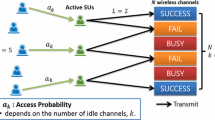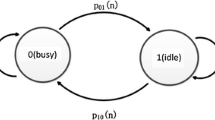Abstract
In this paper we focus on channel exploration problem in the cognitive radio (CR) system, where the exploration process consumes time. The explored channels can be aggregated by CR user for its transmission. CR user adopts a synchronous slotted structure with primary users. Usually, the channel exploration problem is formulated as an optimal stopping problem. However, most previous related works are based on the assumption that channel state changes randomly across slots. In the system, channel state contains channel availability and link quality on the channel. When channel state’s transition across slots follows a Markov process, the problem becomes different. Then we introduce a two-dimension Partially Observable Markov Decision Process framework into the optimal stopping problem. We concentrate on the myopic rule of the new problem. By exploring the structure property of the myopic rule, we can achieve the optimal performance under the myopic rule with a lower computation complexity. To further reduce the computation complexity for a practical application, we then propose a greedy approach. The simulation results show CR user can obtain a near-optimal performance by the greedy approach. The validity of our proposed approaches is also verified by simulation.



Similar content being viewed by others
References
Chen, S., & Zhao, J. (2014). The requirements, challenges, and technologies for 5G of terrestrial mobile telecommunication. IEEE Communications Magazine, 52(5), 36–43.
Poston, J. D., & Horne, W. D. (2005). Discontiguous OFDM considerations for dynamic spectrum access in idle TV channels. In Proceedings of first IEEE symposium on new frontiers in dynamic spectrum access networks.
Jia, J., Zhang, Q., & Shen, X. (2008). HC-MAC: A hardware-constrained cognitive MAC for efficient spectrum management. IEEE Journal on Selected Areas in Communications, 26(1), 106–117.
Khan, Z., Ahmadi, H., Hossain, E., Coupechoux, M., DaSilva, L., & Lehtomäki, J. (2014). Carrier aggregation/channel bonding in next generation cellular networks: Methods and challenges. IEEE Network, 28(6), 34–40.
Zhao, Q., Tong, L., Swami, A., & Chen, Y. X. (2007). Decentralized cognitive MAC for opportunistic spectrum access in ad hoc networks: A POMDP framework. IEEE Journal on Selected Areas in Communications, 25(3), 589–1600.
Zhao, Q., Krishnamachari, B., & Liu, K. (2008). On myopic sensing for multi-channel opportunistic access: Structure, optimality, and performance. Wireless Communications, IEEE Transactions on, 7(12), 5431–5440.
Sabharwal, A., Khoshnevis, A., & Knightly, E. (2007). Opportunistic spectral usage: Bounds and a multi-band CSMA/CA protocol. IEEE/ACM Transactions on Network, 15(3), 533–545.
Chang, N. B., & Liu, M. (2009). Optimal channel probing and transmission scheduling for opportunistic spectrum access. IEEE/ACM Transactions on Network, 17(6), 1805–1818.
Chaporkar, P., & Proutiere, A. (2008). Optimal joint probing and transmission strategy for maximizing throughput in wireless systems. IEEE Journal on Selected Areas in Communications, 26(8), 1546–1555.
Jiang, H., Lai, L., Fan, R., & Poor, H. V. (2009). Optimal selection of channel sensing order in cognitive radio. IEEE Transactions on Wireless Communications, 8(1), 297–307.
Cheng, H. T., & Zhuang, W. (2011). Simple channel sensing order in cognitive radio networks. IEEE Journal on Selected Areas in Communications, 29(4), 1–13.
Wang, Y., Ren, P., & Su, Z. (2011). A POMDP based distributed adaptive opportunistic spectrum access strategy for cognitive ad hoc networks. IEICE Transaction on Communications Letter, E94-B(6), 1621–1624.
Umashankar, G., & Kannu, A. P. (2013). Throughput optimal multi-slot sensing procedure for a cognitive radio. IEEE Communications Letters, 17(12), 2292–2295.
Wang, H. S., & Moayerin, N. (1995). Finite-state Markov channel—A useful model for radio communication channels. IEEE Transactions on Vehicular Technology, 44, 163–171.
Zhang, Q., & Kassam, S. (1999). Finite-state Markov model for Rayleigh fading channels. IEEE Transactions on Communications, 47, 1688–1692.
Wang, Y., Xu, Y., Shen, L., Xu, C., & Cheng, Y. (2014). Two-dimensional POMDP-based opportunistic spectrum access in time-varying environment with fading channels. Journal of Communications and Networks, 16(2), 217–226.
Author information
Authors and Affiliations
Corresponding author
Rights and permissions
About this article
Cite this article
Yin, W., Wu, Q., Wang, J. et al. Channel exploration for aggregation in cognitive radio system. Wireless Netw 23, 419–431 (2017). https://doi.org/10.1007/s11276-015-1168-9
Published:
Issue Date:
DOI: https://doi.org/10.1007/s11276-015-1168-9




